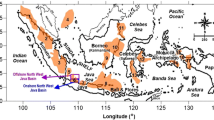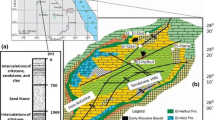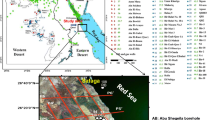Abstract
The occurrence and manifestation of warm and hot springs gives a hint to the availability and abundance of geothermal resources in Nigeria. So for the first time we estimated and quantify the geothermal energy resource potentials in Ikogosi Warm Spring area (IKGWS) and environs using geophysical and Numerical methods. The results from heat flow computation from aeromagnetic investigations and volumetric estimation confirmed there are zones in the IKGWS with anomalous heat flow and great prospects of geothermal energy for direct and indirect applications. The heat flow estimated for the IKGWS and environs ranged from 75 to 127 mW/m2 with an average value of 100 mW/m2 while temperature gradient varied from 28 to 48 °C/Km with a mean value of 38 °C/Km. Also the Curie point depth (CPD) estimated ranged from 12 to 21 km with a mean value of 16 km. The power output of 2 MWe can be produced with 90% confidence and production greater than or equal to 3.7 MW with 5% confidence. The IKGWS isolated will produce 0.9 MWe if the recoverable heat is used for 25 years. The outcomes implied that IKGWS can primarily sustain a 0.9 MW power plant for a period of 25 years and likely extension will be subjected to further well-defined drilling and site data performance availability. The simulation results show that an estimated stored heat in-place of 0.65–1.95 × 10 J can be expected from the inferred resource areas at 90% probability. This figure is equivalent to electric power generation potential of 3.2–9.6 MWe or annual electricity generation of 25–76 GWh at the same probability rate. Therefore Nigeria may appear on the global geothermal map by generating power and direct utilization of geothermal energy in IKGWS.



Similar content being viewed by others

Availability of data and materials
Data for the work will be provided on request.
Abbreviations
- TG:
-
Temp. Grad.
- HF:
-
Heat flow
- IRT:
-
Inferred resource thickness
- RMT:
-
Resource mean temp.
- RSA:
-
Resource surface area
- RD:
-
Rock density
- RSHC:
-
Rock specific heat capacity
- UMS:
-
Undifferentiated meta-sediments
- UBC:
-
Undifferentiated basement complex
References
Abraham EM, Lawal KM, Ekwe AC, Alile O (2014) Murana KA and Lawal AA (2014) Spectral analysis of aeromagnetic data for geothermal energy investigation of Ikogosi Warm Spring - Ekiti State, southwestern Nigeria. Geotherm Energy 2:6
Adegbuyi O, Abimbola AF (1997) Energy resource potential of Ikogosi Warm Spring Area, Ekiti State Southwestern Nigeria. Afri J Sci 1(2):111–117
Adegbuyi O, Ajayi OS, Odeyemi IB (1996) Prospects of hot-dry-rock (HDR) geothermal energy around the Ikogosi warm spring in Ekiti state, Nigeria. J Renew Energy 4:58–64
Anakwuba EK, Onwuemesi AG, Chinwuko AI, Onuba LN (2016) The interpretation of aeromagnetic anomalies over Maiduguri-Dikwa depression, Chad Basin Nigeria: a structural view. Arch Appl Sci Res 3(4):499–508
Anomohanran O (2004) The use of third degree polynomial for accurate conversion of Seismic time to depth and vice versa. J Niger Assoc Math Phys 8:241–246
Baillieux P, Schill E, Edel JB, Mauri G (2013) Localization of temperature anomalies in the Upper Rhine Graben: insights from geophysics and neotectonic activity. Int Geol Rev 55(14):1744–1762
Beardsmore GR, Cull JP (2001) Crustal heat flow: a guide to measurement and modeling. Cambridge University Press
Bonté D, Van Wees JD, Verweij JM (2012) Subsurface temperature of the onshore Netherlands: new temperature dataset and modelling. Geol Mijnbouw-n J G 91:491–515
Bridgman PW (1914) A complete collection of thermodynamics formulas. Phys Rev 3:273. https://doi.org/10.1103/PhysRev.3.273
Brigaud F, Lucazeau F (1985) Heat flow from the West African Shield. Geophys Res Lett 12(9):549–552
Caby R, Boesse JM (2001) Pan-African Nappe system in south west Nigeria; the Ife-Ilesha schist belt. J Afr Earth Sci 33(2):211–225
Chopra P, Holgate F (2005) A GIS analysis of temperature in the Australian crust. In: Proceedings, World Geothermal Congress 2005 Antalya, Turkey, 131pp
Coumou D (2008) Numerical simulation of fluid flow in mid-ocean ridge hydrothermal systems. PhD thesis, ETH Zurich
Emujakporue GO, Ekine AS (2014) Determination of geothermal gradient in the Eastern Niger Delta sedimentary basin from bottom hole temperatures. J Earth Sci Geotech Eng 4(3):109–114
FMPWH (2018) Federal Ministry of Power, Works and Housing. Daily operational report. http://www.pwh.gov.ng/management/uploads_images/15422463228375.pdf. Accessed 14 Nov 2018
Garibaldi C, Guillou-Frottier L, Lardeaux JM, Bouchot V (2010) Combination of numerical tools to link deep temperatures, geological structures and fluid flow in sedimentary basins: application to the thermal anomalies of the province basin (South-East France). In: Proceedings World Geothermal Congress 2010, vol 2010. The International Geothermal Association, Bali, Indonesia, pp 12–17
Guillou-Frottier L, Carré C, Bourgine B, Bouchot V, Genter A (2013) Structure of hydrothermal convection in the Upper Rhine Graben as inferred from corrected temperature data and basin-scale numerical models. J Volcanol Geotherm Res 256:29–49
Ikeagwuani IO, Agbidi DC, Bamisile OO (2015) Exploration and application of geothermal energy in Nigeria. Int J Sci Eng Res 6(2):726–732
Ingebritsen SE, Geiger S, Hurwitz S, Driesner T (2010) Numerical simulation of magmatic hydrothermal systems. Rev Geophys 48(1):RG1002
Kurowska E, Schoeneich K (2010) Geothermal exploration in Nigeria. In: Proceedings, World Geothermal Congress 2010 Bali, Indonesia, pp. 25–29
Lateef MI, Lawal BH, Sedara SO (2019) Qualitative aeromagnetic interpretation over Ikogosi Warm Spring, Southwestern Nigeria. Appl J Phys Sci 1(2):24–36. https://doi.org/10.31248/AJPS2019.019
Lopez S, Hamm V, Le Brun M, Schaper L, Boissier F, Cotiche C, Giuglaris E (2010) Geothermics 40 years of Dogger aquifer management in Ile-de-France, Paris Basin, France. Geothermics 39(4):339–356
Murphy HD (1979) Convective instabilities in vertical fractures and faults. J Geophys Res 1(B11):6121–6130
NERC (2014) Nigerian Electricity Regulatory Commission: http://www.nercng.org/index.php/document-library. Accessed 21 Feb 2014
Odumodu CFR, Mode AW (2016) Geothermal gradients and heat flow variations in parts of the Eastern Niger Delta, Nigeria. J Geol Soc India 88:107–118
Ofor NP, Udensi EE (2014) Determination of the heat flow in the Sokoto Basin, Nigeria using spectral analysis of aeromagnetic data. J Nat Sci Res 4(6):2014
Omokenu EG, Nwosu LI (2016) Statistical analysis of geothermal data of an oil field in parts of Niger Delta, Nigeria. Curr Res Geosci 6(2):91–97
Onuoha KM, Ekine AS (2009) Subsurface temperature variations and heat flow in the Anambra Basin, Nigeria. J Afr Earth Sci 28(3):641–652. https://doi.org/10.1016/S0899-5362(99)00036-6
Oyinloye AO (2011) Geology and geotectonic setting of the basement complex rocks in southwestern Nigeria, Implications on provenance and evolution, earth and environmental sciences. Dr Imran Ahmad Dar, Tech, http://cdn.intechopen.com/pdfs-wm/24552.pdf. GoogleScholar (ISBN ISBN: 978-953-307-468-9)
Pasquale V, Chiozzi P, Verdoya M (2013) Evidence for thermal convection in the deep carbonate aquifer of the eastern sector of the Po Plain, Italy. Tectonophysics 594:1–12
Ragnarsson A (2005) Geothermal development in Iceland 2000-2004. In: World Geothermal Congress, 2005, Antalya. Turkey, April 24–29, 2005, Conference Proceedings, 131pp
Rogers AS, Imevbore AMA, Adegoke OS (1969) Physical and chemical properties of Ikogosi Warm Spring, Southwestern Nigeria. Niger J Mini Geol 4:1–2
Sanyal SK, Sarmiento ZF (2005) Booking geothermal energy reserves. Geotherm Resour Council Trans 29:467–474
Talebi B, O’Connor LK, Sargent SN (2015) Coastal geothermal energy initiative—an approach to quantifying the geothermal energy potential of Queensland, Australia. World Geothermal Congress, Melbourne
Talebi B, Maxwell M, Sargent SN, Bowden S (2010) Queensland coastal geothermal energy initiative-an approach to a regional assessment. In: Proceedings, the 2010 Australian Geothermal Energy Conference, vol 35. Adelaide, SA, pp. 81–86
Tanaka A, Okubo Y, Matsubayashi O (1999) Curie point depth based on spectrum analysis of the magnetic anomaly data in East and Southeast Asia. Tectonophysics 306:461–470
Taylor HS, Glasstone S (1942) A treatise on physical chemistry, 3rd ed., vol 1. D. Van Nostrand Company, New York, pp 454–485
Tournier C, Genthon P, Rabinowicz M (2000) The onset of natural convection in vertical fault planes: consequences for the thermal regime in crystalline basements and for heat recovery experiments. Geophys J Int 140:500–508
UNFCCC (2012) Developing Africa’s Geothermal Sector. Creating mutual value by matching dutch geothermal energy expertise with African Projects. In: United Nations Climate Change Conference 2011 held in Durban, South Africa (Document UNFCCC/CP/2011/9/Add.1)
Verheijen PJT, Ajakaiye DE (1979) Heat-flow measurements in the Ririwai ring complex, Nigeria. Tectonophysics 54:T27–T32
WEC: World Energy Council (2014) http://www.worldenergy.org/data/trilemma-index/country/nigeria/2014/. Accessed 26 Mar 2014
Funding
No funding provided for the research.
Author information
Authors and Affiliations
Contributions
OO developed the concept and design of this work while SO carried out the interpretation of the data and manuscript writing. Authors have read and accepted the manuscript for publication and take public responsibility for the research and have agreed to have our name listed as contributors.
Corresponding author
Ethics declarations
Conflict of interest
The authors declared that there is no competing interest and all authors approved the submission of the manuscript and that the manuscript has not been published elsewhere.
Additional information
Publisher's Note
Springer Nature remains neutral with regard to jurisdictional claims in published maps and institutional affiliations.
Rights and permissions
About this article
Cite this article
Sedara, S.O., Alabi, O.O. Heat flow estimation and quantification of geothermal reservoir of a basement terrain using geophysical and numerical techniques. Environ Earth Sci 81, 70 (2022). https://doi.org/10.1007/s12665-022-10201-6
Received:
Accepted:
Published:
DOI: https://doi.org/10.1007/s12665-022-10201-6



